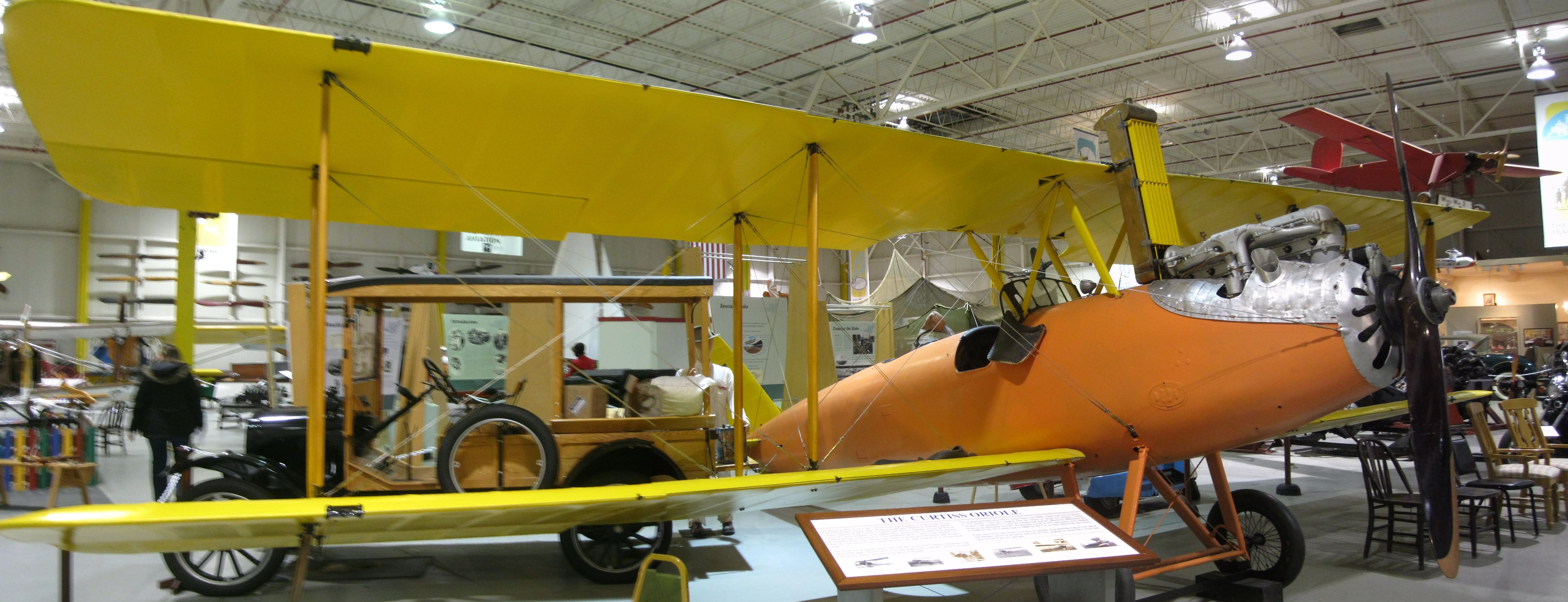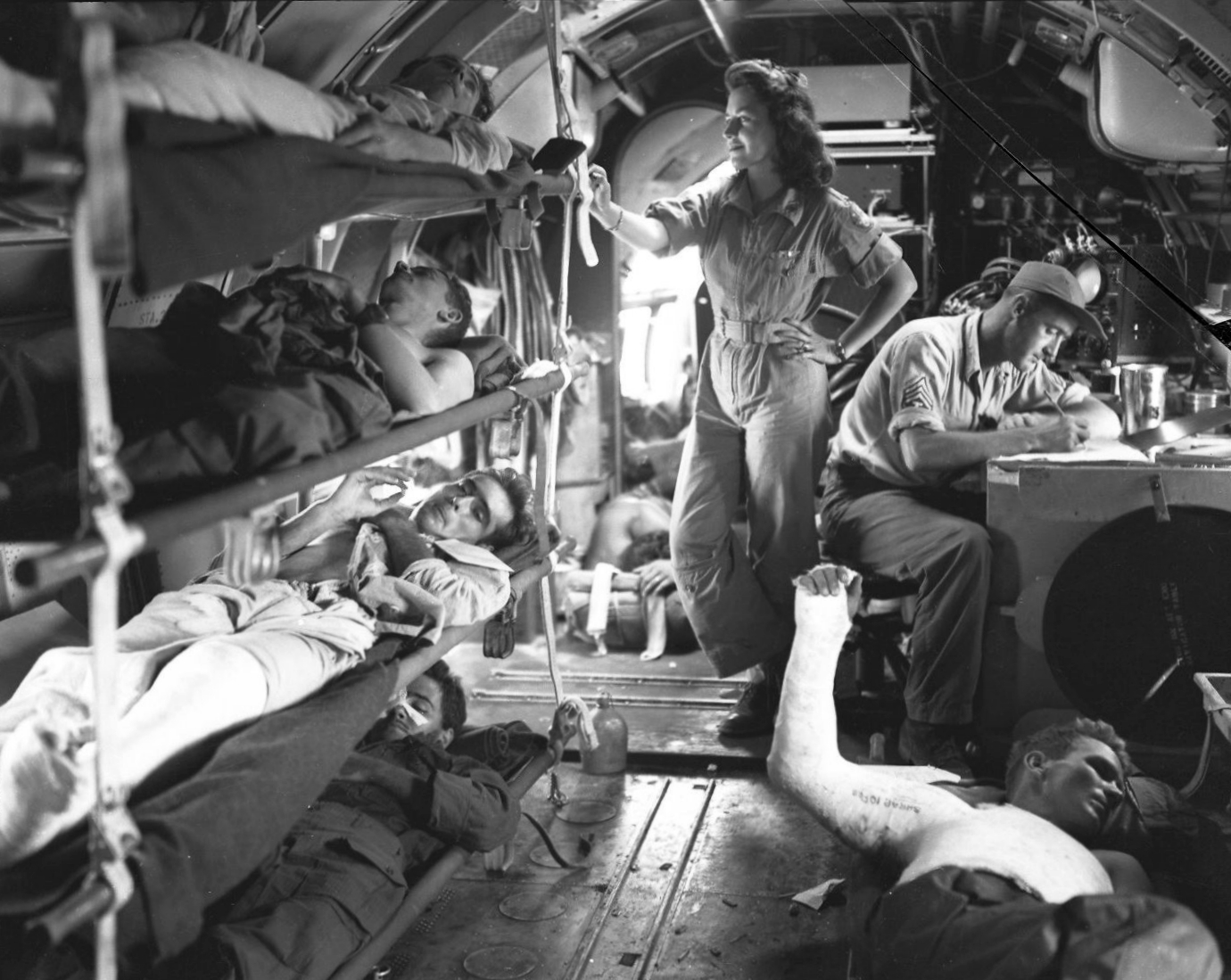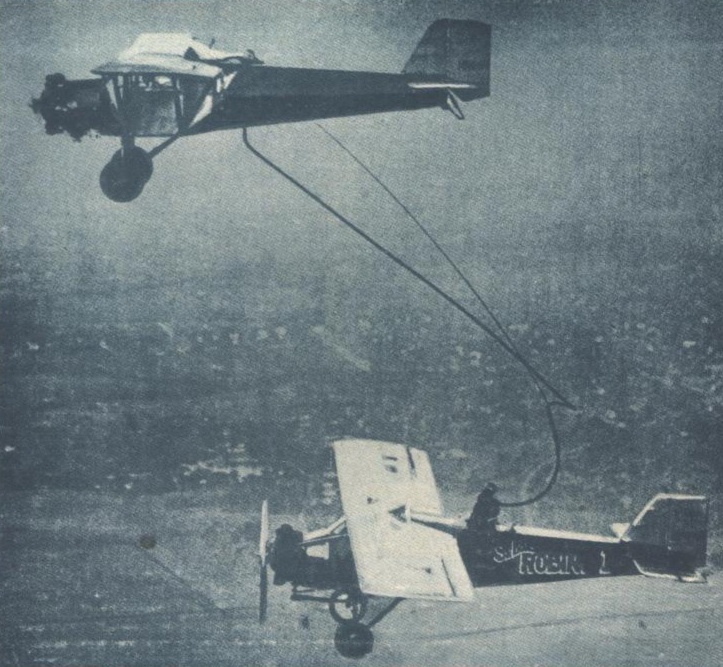|
Glenn H. Curtiss Museum
The Glenn H. Curtiss Museum is a transportation museum in Hammondsport, New York with a focus on the early aviator Glenn H. Curtiss. The 60,000 square foot facility has a collection of aircraft, vintage motorcycles, automobiles, and aircraft engines. History The museum was founded in the summer of 1962 by Otto Kohl. It was originally located in a former high school. However, in 1992, the museum relocated to a former winery building south of Hammondsport. Collection The museum contains over 20 aircraft, including AEA June Bug (reproduction), Curtiss Model D (reproduction), Curtiss Model E, "America" flying boat, JN-4D Jenny, Curtiss Model MF "Seagull", Curtiss Oriole, Curtiss Robin, C-46 Commando, three Mercury Aircraft, a 2/3 scale Curtiss P-40 Warhawk reproduction, and Curtiss-Wright Junior The Curtiss-Wright CW-1 Junior, originally named the Curtiss-Robertson CR-1 Skeeter is a light sports aircraft produced in the United States in the 1930s. It had been intended to ... [...More Info...] [...Related Items...] OR: [Wikipedia] [Google] [Baidu] |
Hammondsport, New York
Hammondsport is a village at the south end of Keuka Lake, in Steuben County, one of the Finger Lakes of New York, United States. The Village of Hammondsport is in the Town of Urbana and is northeast of Bath. History Lazarus Hammond founded the village around 1827. The village was incorporated in 1856. The village later became a center for the New York wine industry. The American motorcycle designer and manufacturer, and recognized expert on gasoline engines Glenn Hammond Curtiss resided at Hammondsport, where he was born in 1878. Early development of aircraft and seaplanes was carried out at Hammondsport by Curtiss who had joined with Alexander Graham Bell and others in the Aerial Experiment Association. In 1921, five local men purchased a wood barrel factory just south of the present D.W. Putnam Wine Company, and named it the Aerial Service Corporation. Two of these men, Henry Kleckler, the president and William Chadeayne, vice president, were formerly with the Curtiss Aer ... [...More Info...] [...Related Items...] OR: [Wikipedia] [Google] [Baidu] |
Curtiss Oriole
The Curtiss Oriole (Curtiss Model 17) was an American three-seat general-purpose biplane. Design The Oriole fuselage was constructed using laminated wood to form a monocoque body and was powered by either the Curtiss OX-5 V-8 or the Curtiss K-6 engine. The aircraft featured a self-starter and a tall thin radiator in the pilot's field of view. Operational history Surplus Curtiss Oriole wings were sold to Harold Pitcairn to manufacture the first production Pitcairn aircraft, the Pitcairn PA-3 Orowing. Northwest Airlines was founded on August 1, 1926, flying a Curtiss Oriole and a Thomas Morse Biplane on the CAM-9 Airmail route from Minneapolis to Chicago. Admiral Byrd selected a Curtiss Oriole as second aircraft for his 1926 Arctic Expedition to the North Pole with a Fokker F.VII. The Oriole was planned to be used for photography and rescue work. The New York times reported (falsely) that the Oriole was shipped on the steamer Chantier in case the Fokker was unavailable. However ... [...More Info...] [...Related Items...] OR: [Wikipedia] [Google] [Baidu] |
Museums In Steuben County, New York
A museum ( ; plural museums or, rarely, musea) is a building or institution that cares for and displays a collection of artifacts and other objects of artistic, cultural, historical, or scientific importance. Many public museums make these items available for public viewing through exhibits that may be permanent or temporary. The largest museums are located in major cities throughout the world, while thousands of local museums exist in smaller cities, towns, and rural areas. Museums have varying aims, ranging from the conservation and documentation of their collection, serving researchers and specialists, to catering to the general public. The goal of serving researchers is not only scientific, but intended to serve the general public. There are many types of museums, including art museums, natural history museums, science museums, war museums, and children's museums. According to the International Council of Museums (ICOM), there are more than 55,000 museums in 202 count ... [...More Info...] [...Related Items...] OR: [Wikipedia] [Google] [Baidu] |
Curtiss-Wright Junior
The Curtiss-Wright CW-1 Junior, originally named the Curtiss-Robertson CR-1 Skeeter is a light sports aircraft produced in the United States in the 1930s. It had been intended to sell it for the price of a mid-range automobile. The Junior had two problems which brought production to a halt: its three-cylinder Szekely SR-3 radial engine tended to throw its cylinders, made more serious by the pusher configuration; and the unexpected location of the propeller caused accidents to people walking up to the plane on the ground. Some Juniors were still being flown in 2012. Design and production Designed as a minimalist, affordable aircraft, the Junior was marketed as "built to sell for the price of an automobile in the medium price class". Curtiss-Robertson's plans to produce such an aircraft were driven by the imminent arrival of the Aeronca C-2 and American Eagle Eaglet on the market. Hoping to compete in the same class, the company purchased the rights to the Snyder Buzzard but soon ... [...More Info...] [...Related Items...] OR: [Wikipedia] [Google] [Baidu] |
Curtiss P-40 Warhawk
The Curtiss P-40 Warhawk is an American single-engined, single-seat, all-metal fighter and ground-attack aircraft that first flew in 1938. The P-40 design was a modification of the previous Curtiss P-36 Hawk which reduced development time and enabled a rapid entry into production and operational service. The Warhawk was used by most Allied powers during World War II, and remained in frontline service until the end of the war. It was the third most-produced American fighter of World War II, after the P-51 and P-47; by November 1944, when production of the P-40 ceased, 13,738 had been built,Murphy and McNiece 2009, p. 83. all at Curtiss-Wright Corporation's main production facilities in Buffalo, New York. P-40 Warhawk was the name the United States Army Air Corps gave the plane, and after June 1941, the USAAF adopted the name for all models, making it the official name in the U.S. for all P-40s. The British Commonwealth and Soviet air forces used the name Tomahawk for models e ... [...More Info...] [...Related Items...] OR: [Wikipedia] [Google] [Baidu] |
Mercury Aircraft
Mercury Corporation was originally an aircraft manufacturer established in Hammondsport, New York in 1920. It built aircraft using the name Mercury Aircraft. Mercury started as an aircraft supply house selling surplus parts for Curtiss JN-4 aircraft flown after World War I. Once the supply of parts ran out, the company manufactured various aircraft components including radios and dirigible gondolas. In 1927, The company renamed itself Mercury Aircraft. It was led by Joseph F. Meade, Sr. and Harvey Mummert. In 1928, Mercury came out with the two place all-metal aircraft, the T-2 Mercury Chic for $3500. With a close relationship to Curtiss aircraft's home. Mercury built a replica of the 1908 AEA June Bug The ''June Bug'' (or ''Aerodrome #3'') was an American "pioneer era" aircraft designed and flown by Glenn H. Curtiss and built by the Aerial Experiment Association (A.E.A) in 1908. The ''June Bug'' is famous for winning the first aeronautical ... in 1976, flying it in airs ... [...More Info...] [...Related Items...] OR: [Wikipedia] [Google] [Baidu] |
C-46 Commando
The Curtiss C-46 Commando is a twin-engine transport aircraft derived from the Curtiss CW-20 pressurised high-altitude airliner design. Early press reports used the name "Condor III" but the Commando name was in use by early 1942 in company publicity. It was used as a military transport during World War II by the United States Army Air Forces and also the U.S. Navy/Marine Corps, which called it R5C. The C-46 served in a similar role to its Douglas-built counterpart, the C-47 Skytrain, but it was not as extensively produced as the latter. After World War II, a few surplus C-46 aircraft were briefly used in their original role as passenger airliners but the glut of surplus C-47s dominated the marketplace and the C-46 was soon relegated to cargo duty. The type continued in U.S. Air Force service in a secondary role until 1968. The C-46 continues in operation as a rugged cargo transport for arctic and remote locations with its service life extended into the 21st century. Design and ... [...More Info...] [...Related Items...] OR: [Wikipedia] [Google] [Baidu] |
Curtiss Robin
The Curtiss Robin, introduced in 1928, was a high-wing monoplane built by the Curtiss-Robertson Airplane Manufacturing Company. The J-1 version was flown by Wrongway Corrigan who crossed the Atlantic after being refused permission. Design The Robin, a workmanlike cabin monoplane, had a wooden wing and steel tubing fuselage. The cabin accommodated three persons; two passengers were seated side-by-side behind the pilot. Early Robins were distinguished by large flat fairings over the parallel diagonal wing bracing struts; the fairings were abandoned on later versions, having been found to be ineffective in creating lift. The original landing gear had bungee rubber cord shock absorbers, later replaced by an oleo-pneumatic system; a number of Robins had twin floats added. Variants of the Robin were fitted with engines which developed . Operational history A single modified Robin (with a Warner R-420-1) was used by the United States Army Air Corps, and designated the ''XC-10''. T ... [...More Info...] [...Related Items...] OR: [Wikipedia] [Google] [Baidu] |
Curtiss Model F
The Curtiss Models F made up a family of early flying boats developed in the United States in the years leading up to World War I. Widely produced, Model Fs saw service with the United States Navy under the designations C-2 through C-5, later reclassified to AB-2 through AB-5. Several examples were exported to Russia, and the type was built under license in Italy. Design and development In configuration, these were biplane flying boats powered by a single Inline engine (aviation), engine mounted amongst the interplane struts and driving a pusher propeller. The pilot and a single passenger sat side by side in an open cockpit. The wing cellule was derived from the Curtiss Model E, Model E landplane and was of two-bay, unstaggered, equal-span construction with large ailerons mounted on the interplane struts and extending past the span of the wings themselves. The earliest examples of this design were built and sold by Curtiss in 1912 without any designation applied to them; the ... [...More Info...] [...Related Items...] OR: [Wikipedia] [Google] [Baidu] |
Transportation Museum
A transport museum is a museum that holds collections of transport items, which are often limited to land transport (road and rail)—including old cars, motorcycles, trucks, trains, trams/streetcars, buses, trolleybuses and coaches—but can also include air transport or waterborne transport items, along with educational displays and other old transport objects. Some transport museums are housed in disused transport infrastructure such as dismantled trolley systems, former engine sheds or bus garages. Many transport museums exist throughout the world, listed below. Argentina * Tramway Histórico de Buenos Aires, Caballito, Buenos Aires Australia * Archer Park Rail Museum, Rockhampton, Queensland * Australian National Maritime Museum, Sydney, New South Wales * Australian Road Transport Heritage Centre, Gundagai, New South Wales * Ballarat Tramway Museum, Ballarat, Victoriabr>* Trams in Bendigo, Bendigo Tram Museum, Bendigo, Victori* Brisbane Tramway Museum, Fern ... [...More Info...] [...Related Items...] OR: [Wikipedia] [Google] [Baidu] |
JN-4D Jenny
The Curtiss JN "Jenny" was a series of biplanes built by the Curtiss Aeroplane Company of Hammondsport, New York, later the Curtiss Aeroplane and Motor Company. Although the Curtiss JN series was originally produced as a training aircraft for the US Army, the "Jenny" (the common nickname derived from "JN") continued after World War I as a civil aircraft, as it became the "backbone of American postWorld War I, war [civil] aviation". Thousands of surplus Jennys were sold at bargain prices to private owners in the years after the war and became central to the barnstorming era that helped awaken the US to civil aviation through much of the 1920s. Design and development Curtiss combined the best features of the Curtiss Model J, model J and Curtiss Model N, model N Training aircraft, trainers, built for the United States Army, US Army and United States Navy, US Navy, and began producing the JN or "Jenny" series of aircraft in 1915. Curtiss built only a limited number of the JN-1 and J ... [...More Info...] [...Related Items...] OR: [Wikipedia] [Google] [Baidu] |
Curtiss Model H
The Curtiss Model H was a family of classes of early long-range flying boats, the first two of which were developed directly on commission in the United States in response to the £10,000 prize challenge issued in 1913 by the London newspaper, the ''Daily Mail'', for the first non-stop aerial crossing of the Atlantic. As the first aircraft having transatlantic range and cargo-carrying capacity, it became the grandfather development leading to early international commercial air travel, and by extension, to the modern world of commercial aviation. The last widely produced class, the Model H-12, was retrospectively designated Model 6 by Curtiss' company in the 1930s, and various classes have variants with suffixed letters indicating differences. Design and development Having transatlantic range and cargo carrying capacity by design, the first H-2 class (soon dubbed ''"The Americans"'' by the Royal Navy) was quickly drafted into wartime use as a patrol and rescue aircraft by the RNAS ... [...More Info...] [...Related Items...] OR: [Wikipedia] [Google] [Baidu] |






.jpg)

